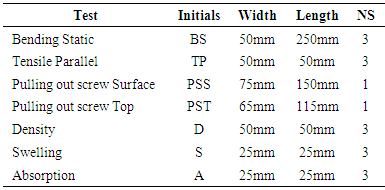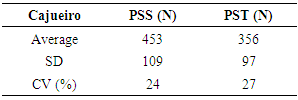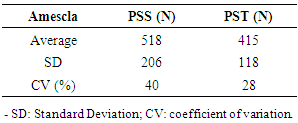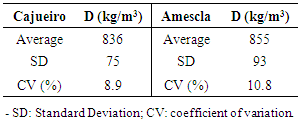Jonathan Francisco de Freitas1, Amós Magalhães de Souza1, Luiz Antônio Melgaço Nunes Granco2, Eduardo Chahud3, André Luis Christoforo4, Francisco Antonio Rocco Lahr5
1Wood and Timber Structures Laboratory (LaMEM), São Carlos Engineering School, São Paulo University (USP), São Carlos - SP, Brazil
2Faculty of Engineering and Architecture, FUMEC University, Belo Horizonte - MG, Brazil
3Department of Civil Engineering, Federal University of Minas Gerais (UFMG), Belo Horizonte - MG, Brazil
4Centre for Innovation and Technology in Composites – CITeC, Department of Civil Engineering (DECiv), Federal University of São Carlos, São Carlos - SP, Brazil
5Department of Structural Engineering (SET), Engineering School of São Carlos (EESC), São Paulo University (USP), São Carlos - SP, Brazil
Correspondence to: André Luis Christoforo, Centre for Innovation and Technology in Composites – CITeC, Department of Civil Engineering (DECiv), Federal University of São Carlos, São Carlos - SP, Brazil.
| Email: |  |
Copyright © 2017 Scientific & Academic Publishing. All Rights Reserved.
This work is licensed under the Creative Commons Attribution International License (CC BY).
http://creativecommons.org/licenses/by/4.0/

Abstract
The most commons woods used for production of medium density particleboard (MDP) are Eucalyptus and Pinus. The Cajueiro and Amescla wood are typical trees coming from the center-west of Brazil, from the States of Mato Grosso and Tocatins. These are medium density woods similar to Pinus sp, the Brazilian’s wood’s industries usually used these woods only as piece of wood for structures or furniture. The purpose of this research is to investigate, in a preliminary study, the possibility of MDP panel’s production using Cajueiro and Amescla wood species. The panels were produced under a pressure of 4 MPa for 10 minutes at 100°C, and it was produced a total of 12 MDP panels, 6 of Cajueiro and 6 of Amescla, with a thickness of 10mm, dimensions 250mm×250mm and 0.5 kg mass. For the bending modulus of elasticity, 2200 MPa were obtained for Cajueiro and 2700 MPa for Amescla, which are considered good values. The results can be considered satisfactory because it is a preliminary and unpublished study in the case of MDP panels manufactured with Cajueiro and Amescla wood species.
Keywords:
Medium density particleboard (MDP), Cajueiro, Amescla, Medium density wood
Cite this paper: Jonathan Francisco de Freitas, Amós Magalhães de Souza, Luiz Antônio Melgaço Nunes Granco, Eduardo Chahud, André Luis Christoforo, Francisco Antonio Rocco Lahr, A Preliminary Study about the Utilization of Cajueiro and Amescla for MDP Panels Production, International Journal of Materials Engineering , Vol. 7 No. 2, 2017, pp. 21-24. doi: 10.5923/j.ijme.20170702.01.
1. Introduction
The wood-based panels are manufactured product with blades or particles in various stages of disintegration, agglutinated by the action of a binder (resin), heat and pressure [1-8, 14].The wood panels were developed in the early twentieth century in America, originally from cellulosic fibers - fiberboards. In the 1920s, the first hardboard pilot plant was built in Sweden, called wallboard [9].However, only during the second world war in Germany is that was produced on a large scale panels for construction due to lack of construction materials. Only in the 1970s US start to produce panels for construction on an industrial scale [10].The wood panels industries start to develop with a technological growing in 1980s, in agreement with a better use of natural resources like wood and also with development of better binders, new types of resins [11]. Wood panels have several applications in furnitures, construction, etc. There are several types of wood panels; one of the most common wood panels is MDP.The material used for the production of medium density particles (MDP) is usually forest residues or waste from wood industries. The most commons woods used for production of MDP panels are Eucalyptus and Pinus. The woods Cajueiro and Amescla are typical trees from center-west from Brazil, from the States of Mato Grosso and Tocatins. These are medium density woods similar to Pinus sp, the Brazilian’s wood’s industries usually used these woods only as piece of wood for structures or furniture.The purpose of this research is to investigate, in a preliminary study, the possibility of MDP panel’s production using Cajueiro and Amescla wood species.
2. Material and Methods
For production of MDP, the particles were produced from the residue of Amescla and Cajueiro timber through a Willye brand knife mill (Marconi model MA 680) with a sieve opening of 2.8mm to obtain the particles. It was produced 8.2kg mass of particle from Amescla and 12,2kg mass of Cajueiro.Later, the particles were mixed with the polyurethane resin castor oil based. Initially it was weighed around 550g of particles and added to 33 g of each resin component.After mixing the particles with the resin, there was the pre-pressing step for forming the particles mattress in a 100Kgf load by an own manual production mechanical press of LaMEM (Wood and Timber Structures Laboratory). After the formation of particles mattress, this was taken to semi-automatic press machine (Marconi model MA 098/50), with a maximum capacity of 800 kN force and maximum temperature of 200°C.The panels were produced under a pressure of 4 MPa for 10 minutes at 100°C, and it was produced a total of 12 MDP panels, 6 of Cajueiro and 6 of Amescla, with a thickness of 10mm, dimensions 250mm×250mm and 0.5 kg mass.After producing the panels, the specimens were obtained for measuring the physical and mechanical properties, according the Brazilian standard ABNT 14810 [12]. Table 1 shows the dimensions and the number of specimens (NS) for each test (by panel).Table 1. Tests made with MDP Panels
 |
| |
|
From each panel it was extracted 3 specimens for the three points static bending static test, 3 specimens for density and tensile parallel to the surface, 3 species to swelling and water absorption, 1 specimen for pulling out screw in the surface and 1 piece for pulling out screw in the top.The parameters obtained in the mechanical tests were the bending stiffness (MOE) and bending strength (MOR), both in MPa, these parameters were calculated by Equations 1 and 2. | (1) |
 | (2) |
From Equations 1 and 2, L is the distance of the panel support (mm), F2 as the load corresponding to the bending of 50% and F1 corresponding to 10% (N) of the maximum load (Fmax), a2-a1 are the difference between the displacements at 50% and 10% of the estimated maximum load (m), b is the width (mm) and t is the thickness (mm).For tensile test parallel to face, the calculations was made according Equation 3, where a and b are the specimens widths in both directions. | (3) |
Density of the samples was obtained using Equation 4. | (4) |
In Equation 4, M is the mass and V the volume of the specimens. Thickness swelling (S) and water absorption (A) were determined (for 2 and 24h) in percentage, using Equations 5and 6, respectively. | (5) |
 | (6) |
From Equations 5 and 6, E2 is the specimen thickness after water immersion; E1 is the thickness before the immersion, M2 is the mass of the specimen after water immersion and M1 is the mass before the water immersion.All the equations are in agreement with Brazilian standard ABNT 14810 [12].
3. Results and Discussion
Tables 2 and 3 shows the values for MOE, MOR and TP for the MDP panels manufactured with Cajueiro and Amescla wood species, respectively.Table 2. Values of MOE, MOR and TP for MDP from Cajueiro
 |
| |
|
Table 3. Values of MOE, MOR and TP for MDP from Amescla
 |
| |
|
We can see different values to MOE and MOR for panels of the MDP from Amescla and Cajueiro. Typical values similar to those found by [11] around 2500 MPa (MOE). The internal bond strength values of both woods were high compared to the values found by [11] and [13], which were around 2 MPa for particulate panels.The mechanical test of the screw pullout top and face were also performed following the Brazilian standard ABNT 14810 [12]. Tables 4 and 5 presents the results of screw pull out surface [PSS] and screw pull out top [PST].Table 4. PSS and PST values for MDP Cajueiro
 |
| |
|
Table 5. PSS and PST values for MDP Amescla
 |
| |
|
Can be observed for the two types of panels a uniformity of values. However, these values were lower than those found by [11], which was 2592 N for the top screw pullout [PST] and 1417 N for screw pullout of surface [PSS].Table 6 shows the values for density of the panels OSB manufactured with Cajueiro and Amescla wood species.Table 6. Values of Density for MDP
 |
| |
|
The values found for density for the panels MDP from Cajueiro was 836 kg/m3 and for the panels MDP from Amescla was 855 kg/m3. Similar values were demonstrated by [11], who obtained around 815 kg/m3 for the panels manufactured with Eucalyptus grandis wood specie.Tables 7 and 8 shows the values of swelling and absorption for the panels MDP manufactured with Cajueiro and Amescla wood species, respectively.Table 7. Swelling and Absorption for Cajueiro
 |
| |
|
Table 8. Swelling and Absorption for Amescla
 |
| |
|
We observe that the MDP obtained values of swelling and absorption similar to that found by [11], who obtained for Eucalyptus grandis average values of 7.13%, and swelling 2h equal to 14.6%.It is possible to relate the obtained swelling and absorption values with density. Cajueiro panel that showed the lowest density (836 kg/m3) compared with the Amescla (855 kg/m3), had higher swelling values for 2h and 24h and absorption 2h and 24h.
4. Conclusions
The production of MDP derivatives from Amescla and Cajueiro wood panels showed a good performance, but is necessary a larger study with these both woods, promoting a treatment with preservative such as chromated copper arsenate - CCA, or chromated copper borate - CCB. Observe how these preservative can affect the mechanical performance of the panels.Increase the number of production MDP, and consequently, increase the number of specimens for physical and mechanical tests to obtain new results enabling a better statistical analysis that was presented in this research.Although it is important to point out the potential of these medium-density woods for the production in industrial level of MDP, given that the MDP obtained (MOE) in the order of 2200 MPa for Cajueiro and 2700 MPa for Amescla, which are considered good values.The results can be considered satisfactory because it is a preliminary and unpublished study about MDP manufactured with Cajueiro and Amescla wood species.
ACKNOWLEDGMENTS
By all support provided, the authors are grateful to Higher Education Improvement Coordination (CAPES) and the National Council for Scientific and Technological Development (CNPq).
References
| [1] | Nascimento, M. F.; Christoforo, A. L.; Fiorelli, J.; Varanda, L. D.; Macedo, L. B.; Lahr, F. A. R. Roughness study on homogeneous layer panels manufactured from treated wood waste. Acta Scientiarum. Technology (Impresso), v. 39, p. 27-32, 2017. |
| [2] | Chiromito, E. M. S.; Campos, C. I.; Ferreira, B. S.; Christoforo, A. L.; Lahr, F. A. R. Propriedades mecânicas de painéis produzidos com lascas de madeira em três diferentes comprimentos. Scientia Forestalis (IPEF), v. 44, p. 175-180, 2016. |
| [3] | Christoforo, A. L.; Nascimento, M. F.; Panzera, T. H.; Ribeiro Filho, S. L. M.; Rocco, F. A. L. Homogeneous Pinus sp. particleboards reinforced with laminated composite materials. Engenharia Agrícola (Online), v. 36, p. 558-565, 2016. |
| [4] | Iwakiri, S. Mendes, L. M. Saldanha, L. K. Produção de chapas de partículas orientadas “OSB” de Eucalyptus grandis com diferentes teores de resina, parafina e composição em camadas. Ciência Florestal, Santa Maria, v. 13, n. 1, p. 89-94, 2002. |
| [5] | Iwakiri, S. A influência de variáveis de processamento sobre propriedades de chapas de partículas de diferentes espécies de Pinus. 1989. 130 f. Tese (Doutorado) – Universidade Federal do Paraná, Curitiba, 1989. |
| [6] | Lahr, F. A. R.; Silva, A. J. P. Disposição Construtivas Aplicada em Painéis Prensados. MU 8603031-0, 05 ago. 2008. |
| [7] | Nascimento, M. F.; Lahr, F. A. R.; Christoforo, A. L.; Bertolini, M. S.; Fiorelli, J., Silva, M. R. Painéis de partículas homogêneas fabricados com resíduos lignoceluósicos e resina alternativa para aplicação em pisos. Scientia Forestalis (IPEF), v. 44, p. 1-8, 2016. |
| [8] | Fiorelli, J., Lahr, F.A.R., Nascimento, M.F., Savastano Júnior, H., Rossignolo, J. A., Painéis de partículas à base de bagaço de cana e resina de mamona – produção e propriedades. Acta Scientiarum Technology. Volume 33 (4), 401-406, 2011. |
| [9] | Gama, R. O. Utilização do rejeito UKP/BKP (unbleach Kraft pulp/ bleach Kraft pulp) da indústria de Celulose em painéis de partículas. 111f. Dissertação (Mestrado em Engenharia Industrial) – Centro Universitário do Leste de Minas Gerais – Unileste MG, Coronel Fabriciano, 2010. |
| [10] | Freitas, J. de F. Estudo Preliminar sobre A Utilização da Cana-de-açúcar e seus Derivados para Produção de Hardboads. 113f. Dissertação (Mestrado em Ciências e Engenharia dos Materiais) Escola de Engenharia de São Carlos, Universidade de São Paulo, São Carlos, 2015. |
| [11] | Varanda, Luciano Donizeti. Produção e avaliação do desempenho de painéis de partículas de Eucalyptus grandis confeccionados com adição de casca de aveia. 2012. 157f. Dissertação (Mestrado em Ciência e Engenharia de Materiais) - Instituto de Química de São Carlos, Instituto de Física de São Carlos e Escola de Engenharia de São Carlos, Universidade de São Paulo, São Carlos, 2012. |
| [12] | Associação Brasileira de Normas Técnicas. NBR 14810: Chapas de madeira aglomerada. Rio de Janeiro, 2006. |
| [13] | Bertolini, M. S. Emprego de resíduos de Pinus sp tratado com preservante de CCB na produção de chapas de partículas homogêneas utilizando resina poliuretana à base de mamona. 2011. 129f. Dissertação (Mestrado em Ciências e Engenharia dos Materiais) – Instituto de Química de São Carlos, Instituto de Física de São Carlos e Instituto de Engenharia de São Carlos, Universidade de São Paulo, São Carlos, 2011. |









 Abstract
Abstract Reference
Reference Full-Text PDF
Full-Text PDF Full-text HTML
Full-text HTML






